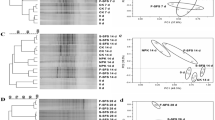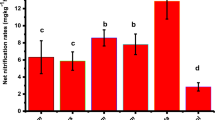Abstract
Purpose
Vegetables are major economic crops in China. Their cultivation usually involves high fertilizer application rates leading to significant losses of N and P to the wider environment, resulting in water contamination and low nutrient use efficiency. Hence, it is a matter of urgency to understand the mechanisms and factors that affect N and P losses in vegetable production systems in order to develop optimum fertilization regimes.
Materials and methods
Different fertilization regimes were applied in a long-term chili (Capsicum spp. L.) production soil to study the effects on nitrogen (N) and phosphorus (P) runoff losses, microbial biomass, microbial community, and crop yields. Three fertilization regimes were implemented: control (no fertilizer; CK), farmer’s fertilization practice (FFP), and site-specific nutrient management (SSNM). A fixed collection device was used to quantify the total volume of water output after each precipitation event. All water samples were analyzed for total nitrogen, ammonium nitrogen (NH4+-N), nitrate nitrogen (NO3−-N), total phosphorus (TP), and available phosphorus (AP). Soil samples were collected for analysis of the physicochemical properties and for DNA extraction after chili harvest. High-throughput sequencing was used to further investigate the relationship between the microbial community and nutrient losses.
Results and discussion
The SSNM fertilizer regime resulted in a 23.3% yield increase and enhanced agronomic N use efficiency from 11.87 to 15.67% compared with the FFP treatment. Soil available nutrients (i.e., AN and AP) and ATP content increased significantly after SSNM implementation. Under the SSNM regime, N losses decreased by 25.8% compared with FFP but did not lead to significantly different P losses. High-throughput sequencing results showed that each treatment formed a unique microbial community structure. VPA results revealed that the microbial community structure was mainly (50.56%) affected by the interactions between N and P. Mantel results indicated that the soil properties that significantly affected soil microbial community structure followed the order: AP, AK, and salinity.
Conclusions
Our study has demonstrated that SSNM not only generates lower N losses but also provides higher contents of soil available nutrients and plant yield, which were mainly attributed to the multiple top dressings and meeting of the plants’ demand with adequate nutrient supplies. The combined data showed that the microbial community differentiation between the different fertilizer regimes was mainly linked to the interactions between N and P in the soil.




Similar content being viewed by others
References
Acosta-Martinez V, Dowd S, Sun Y, Allen V (2008) Tag-encoded pyrosequencing analysis of bacterial diversity in a single soil type as affected by management and land use. Soil Boil Biochem 40:2762–2770
Adeola O (1999) Nutrient management procedures to enhance environmental conditions: an introduction. J Anim Sci 77:427–429
Albiac J (2009) Nutrient imbalances: pollution remains. Science 326:665–665
Broadhurst MJ, Ardeshir A, Kanwar B, Mirpuri J, Gundra UM, Leung JM, Wiens KE, Vujkovic-Cvijin I, Kim CC, Yarovinsky F, Lerche NW, McCune JM, Loke P (2012) Therapeutic helminth infection of macaques with idiopathic chronic diarrhea alters the inflammatory signature and mucosal microbiota of the colon. PLoS Pathog 8(11):e1003000
Cardinale BJ, Srivastava DS, Duffy JE, Wright JP, Downing AL, Sankaran M, Jouseau C (2006) Effects of biodiversity on the functioning of trophic groups and ecosystems. Nature 443:989–992
Carpenter SR, Caraco NF, Correll DL, Howarth RW, Sharpley AN, Smith VH (1998) Nonpoint pollution of surface waters with phosphorus and nitrogen. Ecol Appl 8:559–568
Chaer G, Fernandes M, Myrold D, Bottomley P (2009) Comparative resistance and resilience of soil microbial communities and enzyme activities in adjacent native forest and agricultural soils. Microb Ecol 58:414–424
Deluca TH (2009) Nutrient imbalances: follow the waste. Science 326:665–665 665; author reply 666
Di HJ, Cameron KC (2002) Nitrate leaching in temperate agroecosystems: sources, factors and mitigating strategies. Nutr Cycl Agroecosys 64:237–256
Dixon P (2003) VEGAN, a package of R functions for community ecology. J Veg Sci 14:927–930
Djodjic F, Borling K, Bergstrom L (2004) Phosphorus leaching in relation to soil type and soil phosphorus content. J Environ Qual 33:678–684
Dobermann A, Witt C, Abdulrachman S, Gines HC, Nagarajan R, Son TT, Tan PS, Wang GH, Chien NV, Thoa V, Phung CV, Stalin P, Muthukrishnan P, Ravi V, Babu M, Simbahan GC, Adviento M (2003) Soil fertility and indigenous nutrient supply in irrigated rice domains of Asia. Agron J 95:913–923
Food and Agriculture Organization (FAO). United Nations (2011) FAO statistical databases.
Fierer N, Bradford MA, Jackson RB (2007) Toward an ecological classification of soil bacteria. Ecology 88:1354–1364
Jenkinson DS, Oades JM (1979) Method for measuring adenosine-triphosphate in soil. Soil Boil Biochemist 11:193–199
Jones RT, Robeson MS, Lauber CL, Hamady M, Knight R, Fierer N (2009) A comprehensive survey of soil acidobacterial diversity using pyrosequencing and clone library analyses. ISME J 3:442–453
Ju XT, Kou CL, Zhang FS, Christie P (2006) Nitrogen balance and groundwater nitrate contamination: comparison among three intensive cropping systems on the North China Plain. Environ Pollut 143:117–125
Khurana HS, Phillips SB, Singh B, Alley MM, Dobermann A, Sidhu AS, Singh Y, Peng S (2008) Agronomic and economic evaluation of site-specific nutrient management for irrigated wheat in Northwest India. Nutr Cycl Agroecosys 82:15–31
Li C, Yan K, Tang L, Jia Z, Li Y (2014) Change in deep soil microbial communities due to long-term fertilization. Soil Biol Biochem 75:264–272
Liang XQ, Chen YX, Nie ZY, Ye YS, Liu J, Tian GM, Wang GH, Tuong TP (2013) Mitigation of nutrient losses via surface runoff from rice cropping systems with alternate wetting and drying irrigation and site-specific nutrient management practices. Environ Sci Pollut Res 20:6980–6991
Lin D, Fan X, Hu F, Zhao H, Luo J (2007) Ammonia volatilization and nitrogen utilization efficiency in response to urea application in rice fields of the Taihu Lake region, China. Pedosphere 17:639–645
Liu E, Yan C, Mei X, He W, Bing SH, Ding L, Liu Q, Liu S, Fan T (2010) Long-term effect of chemical fertilizer, straw, and manure on soil chemical and biological properties in Northwest China. Geoderma 158:173–180
Nacke H, Thuermer A, Wollherr A, Will C, Hodac L, Herold N, Schoening I, Schrumpf M, Daniel R (2011) Pyrosequencing-based assessment of bacterial community structure along different management types in German forest and grassland soils. PLoS One 6(2):e17000
Nemergut DR, Townsend AR, Sattin SR, Freeman KR, Fierer N, Neff JC, Bowman WD, Schadt CW, Weintraub MN, Schmidt SK (2008) The effects of chronic nitrogen fertilization on alpine tundra soil microbial communities: implications for carbon and nitrogen cycling. Environ Microbiol 10:3093–3105
Pampolino MF, Manguiat IJ, Ramanathan S, Gines HC, Tan PS, Chi TTN, Rajendran R, Buresh RJ (2007) Environmental impact and economic benefits of site-specific nutrient management (SSNM) in irrigated rice systems. Agric Syst 93:1–24
Peng S, Yang S, Xu J, Luo Y, Hou H (2011) Nitrogen and phosphorus leaching losses from paddy fields with different water and nitrogen managements. Paddy Water Environ 9:333–342
Pote DH, Daniel TC, Sharpley AN, Moore PA, Edwards DR, Nichols DJ (1996) Relating extractable soil phosphorus to phosphorus losses in runoff. Soil Sci Soc Am J 60:855–859
Redmile-Gordon M, White RP, Brookes PC (2011) Evaluation of substitutes for paraquat in soil microbial ATP determinations using the trichloroacetic acid based reagent of Jenkinson and Oades (1979). Soil Biol Biochem 43:1098–1100
Rietz DN, Haynes RJ (2003) Effects of irrigation-induced salinity and sodicity on soil microbial activity. Soil Biol Biochem 35:845–854
Rosenfeld JK (1979) Ammonium adsorption in nearshore anoxic sediments. Limnol Oceanogr 24:356–364
Segata N, Izard J, Waldron L, Gevers D, Miropolsky L, Garrett WS, Huttenhower C (2011) Metagenomic biomarker discovery and explanation. Genome Biol 12(6):R60
Shan L, He Y, Chen J, Huang Q, Lian X, Wang H, Liu Y (2015) Nitrogen surface runoff losses from a Chinese cabbage field under different nitrogen treatments in the Taihu Lake Basin, China. Agr Water Manage 159:255–263
Vance ED, Brookes PC, Jenkinson DS (1987) An extraction method for measuring soil microbial biomass-C. Soil Biol Biolchem 19:703–707
Verhoeven J, Koerselman W, Meuleman A (1996) Nitrogen- or phosphorus-limited growth in herbaceous, wet vegetation: relations with atmospheric inputs and management regimes. Trends Ecol Evol 11:494–497
Zhang Q, Shamsi IH, Wang J, Song Q, Xue Q, Yu Y, Lin X, Hussain S (2013) Surface runoff and nitrogen (N) loss in a bamboo (Phyllostachys pubescens) forest under different fertilization regimes. Environ Sci Pollut Res 20:4681–4688
Zhao J, Ni T, Li Y, Xiong W, Ran W, Shen B, Shen Q, Zhang R (2014) Responses of bacterial communities in arable soils in a rice-wheat cropping system to different fertilizer regimes and sampling times. PLoS One 9(1):e85301
Zhao J, Ni T, Li J, Lu Q, Fang Z, Huang Q, Zhang R, Li R, Shen B, Shen Q (2016) Effects of organic-inorganic compound fertilizer with reduced chemical fertilizer application on crop yields, soil biological activity and bacterial community structure in a rice-wheat cropping system. Appl Soil Ecol 99:1–12
Zheng XH, Han SH, Huang Y, Wang YS, Wang MX (2004) Re-quantifying the emission factors based on field measurements and estimating the direct N(2)O emission from Chinese croplands. Global Biogeochem Cy 18(2). https://doi.org/10.1029/2003GB002167
Zhu ZL, Chen DL (2002) Nitrogen fertilizer use in China—contributions to food production, impacts on the environment and best management strategies. Nutr Cycl Agroecosys 63:117–127
Zhu T, Zhang J, Yang W, Cai Z (2013) Effects of organic material amendment and water content on NO, N2O, and N2 emissions in a nitrate-rich vegetable soil. Biol Fert Soils 49:153–163
Funding
The authors gratefully acknowledge the financial support from the National Key Science and Technology Project: Water Pollution Control and Treatment (2014ZX07101-012), the National Key Research and Development Program of China (2016YFD0801103), and Science & Research Program of Zhejiang Province (Grant No. 2016C32084).
Author information
Authors and Affiliations
Corresponding author
Additional information
Responsible editor: Zucong Cai
Electronic supplementary material
ESM 1
(DOCX 193 kb)
Rights and permissions
About this article
Cite this article
Yi, B., Zhang, Q., Gu, C. et al. Effects of different fertilization regimes on nitrogen and phosphorus losses by surface runoff and bacterial community in a vegetable soil. J Soils Sediments 18, 3186–3196 (2018). https://doi.org/10.1007/s11368-018-1991-6
Received:
Accepted:
Published:
Issue Date:
DOI: https://doi.org/10.1007/s11368-018-1991-6




